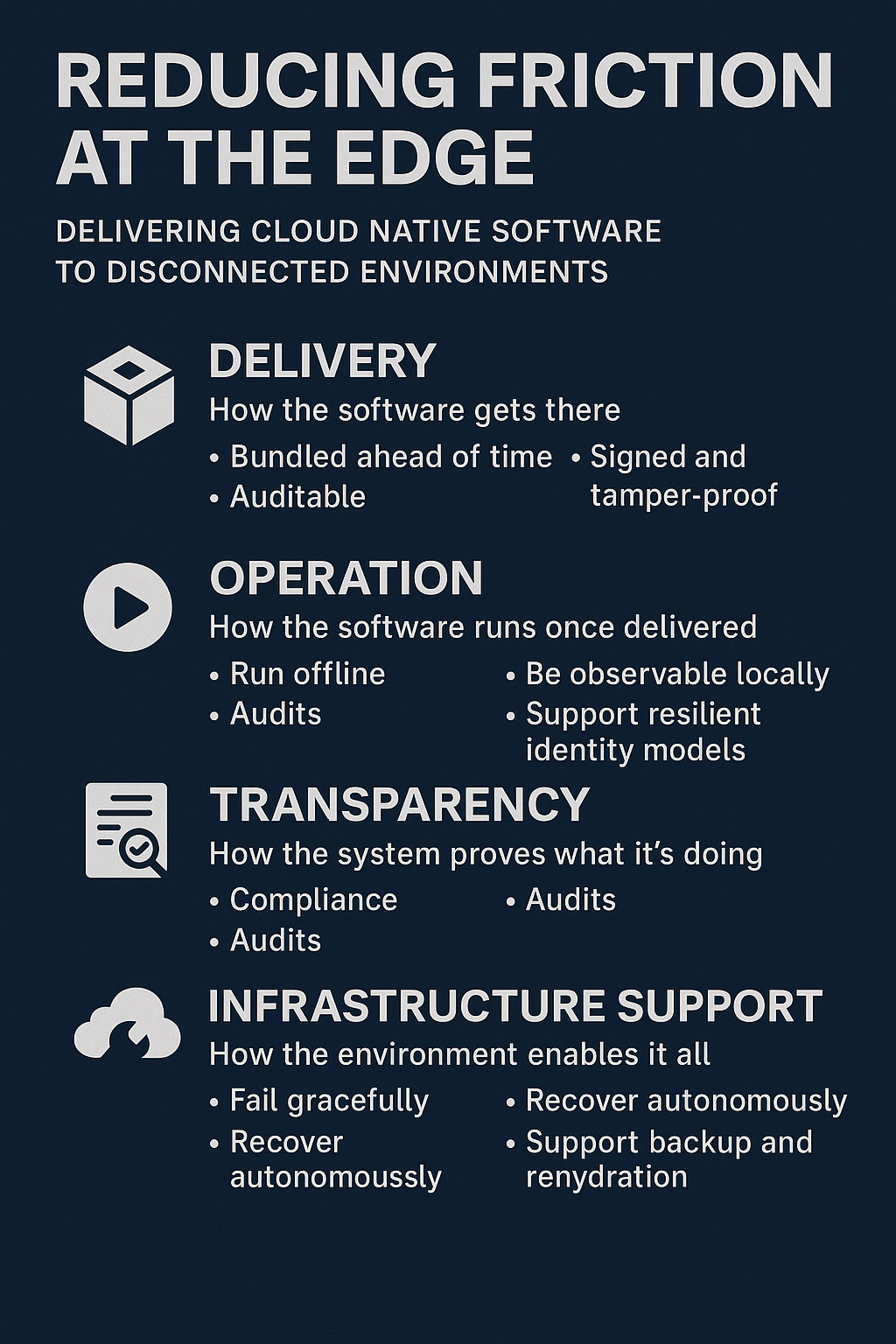
We’ve talked about personas.
We’ve talked about environments.
Now we need to talk about delivery.
Because for all the advances in containerization, infrastructure as code, and supply chain security—getting software to run in disconnected or semi-connected environments is still far too hard.
And the reasons why come down to friction.
Disconnection Isn’t New—But Our Tooling Assumes It Is
Disconnected systems have existed for decades: industrial control networks, classified enclaves, and remote field operations. What’s changed is the expectation that these environments should run modern, cloud-native applications—and the tooling that assumes a persistent cloud connection to do so.
What we often see in practice is one of two failure modes:
-
Disconnection isn’t supported at all.
The system assumes public registry access, cloud-based identity, and SaaS integrations. -
Disconnection is supported—but barely.
The process involves pages of manual steps, brittle one-off scripts, and hidden assumptions that break easily.
In both cases, friction is the enemy—friction that turns an otherwise well-architected system into a support nightmare when pushed beyond its comfort zone.
The Four Layers of Friction
Delivering cloud-native software to disconnected environments isn’t just about pushing a container image. It’s about reducing friction across four interlocking layers:
1. Delivery: How the Software Gets There
Disconnected environments can’t docker pull. They can’t helm repo add. They may not even have a reliable sync mechanism.
So every artifact—container images, manifests, charts, policies—needs to be:
- Bundled ahead of time, with complete dependency trees.
- Signed and tamper-proof, to meet supply chain security requirements.
- Auditable, so operators can trace exactly what’s being delivered.
Friction here looks like:
- Custom export scripts with implicit dependencies.
- Separate packaging for software vs. metadata.
- Inconsistent or manual artifact verification processes.
2. Operation: How the Software Runs Once Delivered
In cloud-connected environments, applications expect dynamic configuration via APIs, instant logs via observability backends, and auth via identity providers.
In disconnected environments, none of that is guaranteed.
Your software must:
- Run offline, with no dependency on real-time APIs.
- Be observable locally, or queue telemetry for later upload.
- Support resilient identity models, like pre-baked service tokens or hardware-based attestation.
If the system falls apart without internet, it’s not a good fit for the edge.
3. Transparency: How the System Proves What It’s Doing
Disconnected doesn’t mean unregulated. In fact, many of the most disconnected environments are also the most controlled—like classified enclaves or critical infrastructure.
Transparency is key:
- What software is running?
- What was delivered?
- What changed, and when?
This isn’t just about logs—it’s about compliance, audits, and approvals.
Friction shows up as:
- Unverifiable config drift.
- Manual SBOM generation.
- Opaque pipelines that obscure provenance.
4. Infrastructure Support: How the Environment Enables It All
Your application can be perfectly packaged and secure—but if the platform underneath it can’t support disaster recovery, resiliency, or degraded operations without cloud APIs, it doesn’t matter.
Disconnected infrastructure must:
- Fail gracefully, with local fallback logic.
- Recover autonomously, without calling home.
- Support backup and rehydration workflows natively.
A reliable disconnected platform treats cloud APIs as enhancements—not dependencies.
Friction Is a Design Smell
When delivering to the edge feels like pulling teeth, it’s a signal:
The system was not designed with disconnection in mind.
But this isn’t just about edge use cases. These principles benefit connected environments, too:
- Prepackaging software helps speed up recovery in cloud outages.
- Local observability makes systems more resilient under load.
- Stronger provenance and transparency improve trust and auditability across the board.
Designing for disconnection doesn’t limit capability—it sharpens it.
The Path Forward
To serve the growing class of disconnected and semi-connected environments, we need to:
- Simplify software delivery with repeatable, declarative bundles.
- Ensure offline-first operation without breaking cloud-native patterns.
- Embed supply chain metadata as a first-class citizen in the packaging process.
- Design platforms that don’t assume connectivity as a precondition for resiliency.
Because disconnection isn’t the exception anymore.
It’s an emerging norm.
And our software delivery workflows need to catch up.
Want to go deeper?
- Check out the Zarf project for building packages that run across the spectrum
- Join the
#zarfchannel in Kubernetes Slack - Or hit me up on socials to chat about the weirdest places you’ve deployed an app